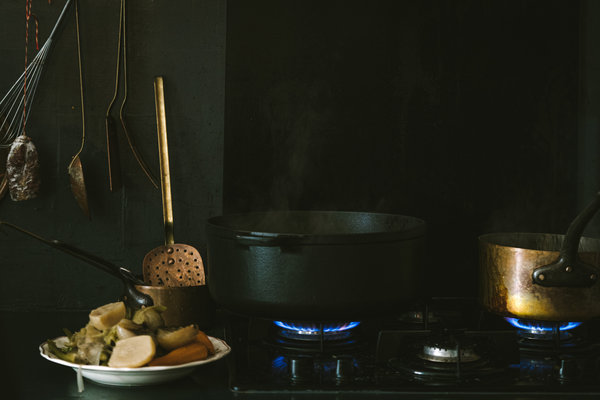At around 8 a.m. on a recent Tuesday morning, the Australian chefs James Henry, 36, and Shaun Kelly, 35, fired up a mud-splattered Renault van and set off from the French village of Saint-Vrain, where they live, to Paris, 30 miles north. Once a week, for the past six months, the pair has crawled through the commuter traffic to deliver the produce they harvest from their three-acre vegetable garden to some of the capital’s most exciting restaurants. Today, crates of heirloom carrots, Hokkaido pumpkins, icicle radishes, white beets, Korean Nogak cucumbers and sprays of coriander are destined for the kitchens at chef Bertrand Grébaut’s Michelin-starred bistro Septime, the wildly popular market-driven cafe Mokonuts and the chef Iñaki Aizpitarte’s trailblazing neo-bistro Le Chateaubriand, among others.
The first port of call today is the Italian restaurant Passerini, where the Roman chef Giovanni Passerini surveys a raft of radicchio with a look of unbridled joy. “This is the beginning of happiness: It means the puntarella is coming,” he says, referring to the chicory he awaits, adding that he plans to serve the radicchio that evening with sweetbreads. It’s a good match, Kelly conveys with an approving nod. Similar exchanges happen throughout the day, as chefs probe Henry and Kelly for their thoughts on the taste and texture of their produce. The pair is uniquely well positioned to offer their insights: In addition to the deep and wide-ranging knowledge of produce they have amassed as growers, they have both worked their way up through the ranks of the Parisian food scene as chefs. Henry put the buzzy shared-plate bistro Au Passage on the map before he opened the more refined Bones (now called Jones, under new leadership), while Kelly, who’d spent time cooking at the British chef Fergus Henderson’s pioneering nose-to-tail eatery St. John in London, took over for Henry at Au Passage before running the kitchen at the lively 11th arrondissement bistro Yard. “We see the value in things that others might not, like chefs being interested in what someone might consider a waste product — like broccoli leaves — or of buying things that have gone to flower,” Henry says, holding up a bunch of coriander flowers destined for the menu at Le Chateaubriand.
Supplying produce to top restaurants was not part of Henry and Kelly’s plan, but growing vegetables was. Since 2017, the two friends have been working toward opening an ambitious 40-seat farm-to-table restaurant, with 10 bedrooms for overnight stays, set on the grounds of a 19th-century private estate belonging to their silent investor, on the outskirts of Saint-Vrain. Called Le Doyenné, the project will occupy the property’s former stables, which will be completely renovated, with airy interiors designed by Ciguë, the Parisian architectural firm that has created spaces for the skin-care brand Aesop and the fashion label Isabel Marant.

In the meantime, the pair has spent the past year laying the groundwork for the farm. Last summer, they planted an orchard — with multiple varieties of prunes, quinces, apples, cherries, pears and mulberries — then set about creating 10 vegetable plots arranged with more than 100 heirloom varieties sourced from around the world. Neither Henry nor Kelly have previous experience in working the land, but they devoured books and online tutorials about different gardening methods before settling on a version of the no-dig system — which involves planting directly into a topsoil of organic mulch — championed by the celebrated British horticulturalist Charles Dowding. The first yield surpassed all expectations; with spring and summer came a bounty of sugary peas, Ananas Noire tomatoes, Armenian cucumbers, tomatillos, trumpet zucchini and aromatic herbs. “The goal this year was really to see how we would produce, in terms of quality and quantity, and to get an idea of how it will work with the restaurant,” says Kelly, but they didn’t want the harvest to go to waste. “As things started to come in, we would just call up Bertrand at Septime and say, ‘Hey we have 20 kilograms of peas, are you interested?’” adds Henry.
In the months ahead, the duo will focus on getting the rest of the site up and running — an undertaking that involves carving out new roads, creating parking and gut-renovating the stables. At the end of the garden, they’ve already meticulously restored a 19th-century greenhouse, where they will plant peppers and aubergines, germinate seedlings and experiment with cold-hardy citrus over the winter months.
Kelly and Henry will likely be back in the delivery van come spring, but once the restaurant opens next summer, their priority will be to supply their own kitchen and farm shop. Naturally, the daily menu at the restaurant will be guided entirely by the garden. “Freshness is a huge part of wanting to do this because there are so many different ways you could cook throughout a season,” says Henry. With easy access, they can serve that first sweet flush of peas raw, and then cook them in new and different ways as the season unfolds. “For chefs,” says Henry, “this is a dream.”




